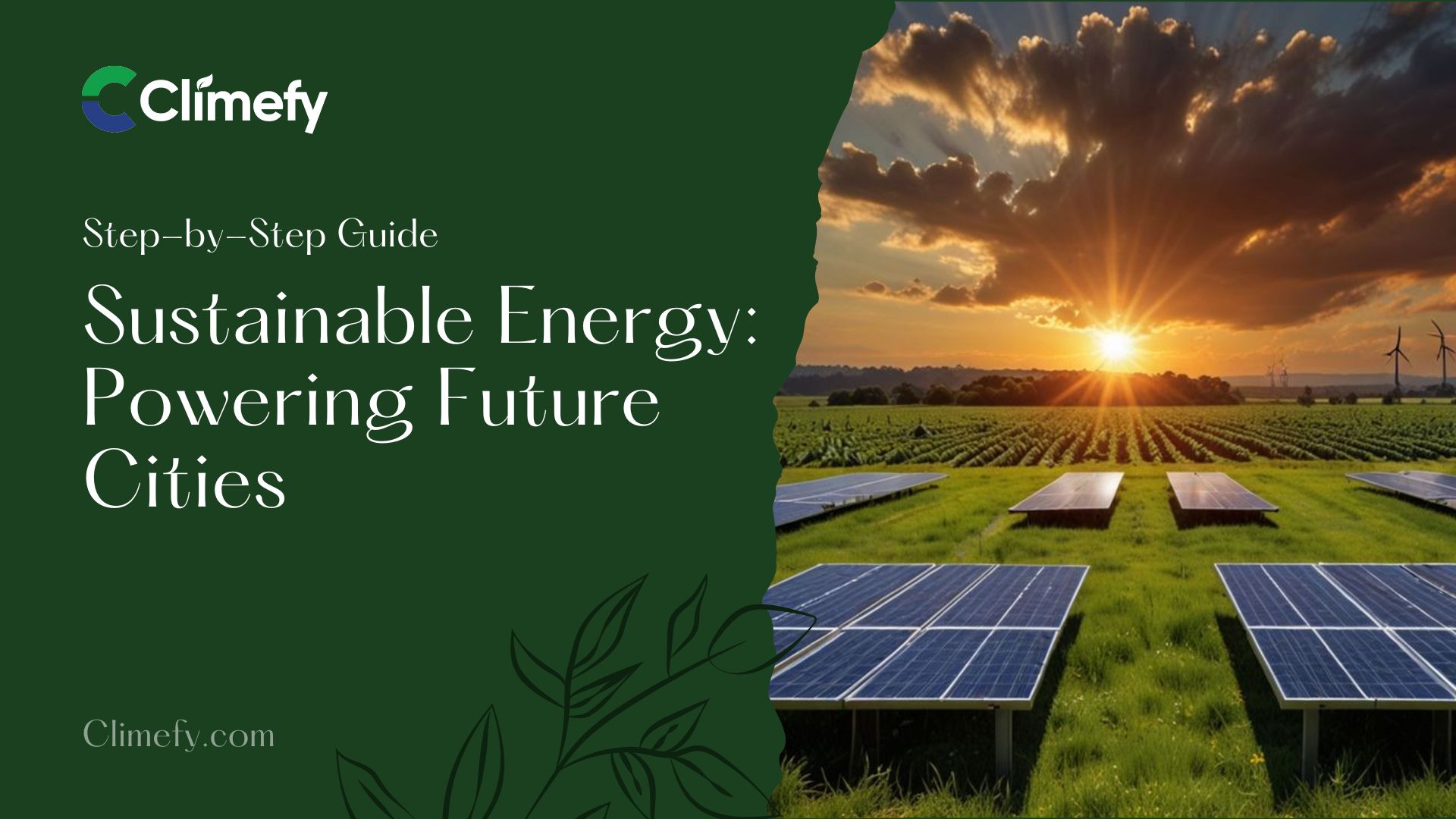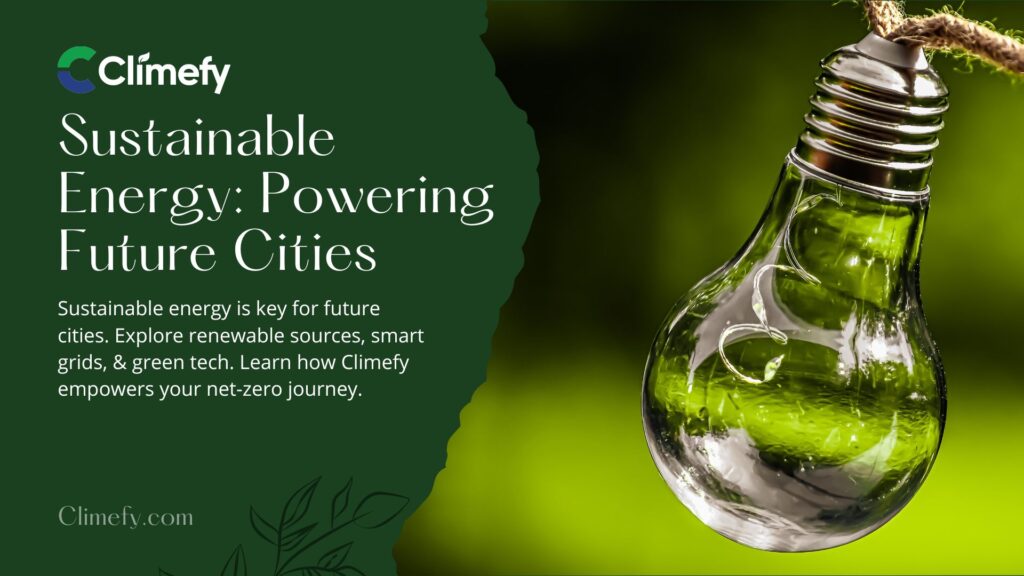

Sustainable energy is the cornerstone of building resilient, efficient, and livable future cities. As global urbanization accelerates, the traditional fossil fuel-based energy model proves increasingly untenable, necessitating a fundamental shift towards clean, renewable, and intelligent power systems. This transition is not merely about swapping energy sources; it is a comprehensive re-imagining of how cities generate, distribute, store, and consume energy, integrating advanced technology, data analytics, and community engagement to create a harmonious balance between human habitat and the natural environment.
In this definitive guide, you will learn:
Read More:

Sustainable energy, often used interchangeably with renewable energy but encompassing a broader philosophy, refers to energy sources and practices that meet the needs of the present without compromising the ability of future generations to meet their own needs. It is characterized by four key pillars: it is renewable (derived from naturally replenishing sources), clean (produces little to no greenhouse gas emissions or pollutants during operation), efficient (minimizes waste throughout the energy lifecycle), and accessible (technologically and economically viable for widespread adoption). For future cities, sustainable energy is not an alternative but a prerequisite.
It is the engine that will power economic activity, heat and cool homes, fuel transportation, and drive digital innovation, all while ensuring public health, energy security, and ecological integrity. The shift from centralized, carbon-intensive power systems to decentralized, clean energy networks is fundamental to mitigating climate change, reducing urban air pollution, and building cities that can thrive in the long term. The core objective is to decouple urban growth from environmental degradation, creating a positive feedback loop where development enhances, rather than depletes, natural and social capital.
The portfolio of sustainable energy sources is diverse, drawing from the immense power of natural phenomena. Each source has unique characteristics, infrastructure requirements, and ideal applications, making them complementary components of a robust urban energy system. Understanding these sources is the first step in appreciating the complexity and promise of the energy transition.
Solar power captures energy from sunlight and converts it into electricity or heat. It is one of the most accessible and rapidly growing renewable energy sources globally. The two primary technologies are photovoltaic (PV) systems, which use semiconductor cells to directly convert sunlight into electricity, and concentrated solar power (CSP), which uses mirrors to focus sunlight to heat a fluid that drives a turbine.
For cities, solar installations can be scaled from massive utility-scale solar farms on the urban periphery to rooftop solar panels on residential and commercial buildings, and even integrated into building materials as solar windows or facades.
Wind energy utilizes the kinetic energy of moving air to spin large turbines, which generate electricity. Onshore wind farms are a cost-effective power source, while offshore wind farms, located in bodies of water, benefit from stronger and more consistent winds. Modern wind turbine technology has seen significant advances, with larger, more efficient turbines capable of powering thousands of homes.
For coastal cities, offshore wind represents a massive, untapped clean energy resource that can provide a stable and significant portion of the urban energy load.
These sources provide consistent, reliable baseload power, complementing the intermittency of solar and wind.
Hydropower generates electricity by capturing the energy of flowing water, typically from dams or river currents. It is one of the oldest and most established renewable sources. Geothermal energy exploits the Earth’s internal heat, accessed by drilling deep wells to steam or hot water reservoirs that can drive turbines for electricity or provide direct heating for districts and buildings.
The sustainable energy landscape is continually evolving with promising new technologies. Biomass energy involves converting organic materials like agricultural residues, wood chips, and even municipal solid waste into energy through combustion, gasification, or anaerobic digestion. When sourced sustainably, it can be carbon-neutral.
Green Hydrogen, produced by splitting water using renewable electricity, is a clean fuel and energy storage medium for hard-to-decarbonize sectors like heavy industry and long-haul transport. Tidal and Wave Energy capture the kinetic and potential energy of oceans, though still in earlier stages of commercialization.
A smart grid is an electricity network that uses digital communication technology, sensors, and automation to monitor and manage the flow of electricity from all generation sources to meet the varying electricity demands of end-users. It is the central nervous system of a sustainable energy city. Unlike traditional “dumb” grids that operate unidirectionally, smart grids enable a two-way flow of both electricity and information.
This allows for real-time balancing of supply and demand, integration of distributed energy resources (like rooftop solar), and improved resilience against outages. Artificial Intelligence (AI) and Machine Learning supercharge smart grids by analyzing vast datasets to predict energy demand, optimize generation and distribution, detect faults, and even enable dynamic pricing. For instance, AI can signal smart appliances in homes to reduce power consumption during peak demand, a process known as demand-side response.
The intermittency of key renewable sources like solar and wind—the sun doesn’t always shine, and the wind doesn’t always blow—is the primary challenge for a 100% renewable grid. Energy storage is the solution that decouples energy generation from consumption, allowing cities to store excess energy when production is high and discharge it when demand peaks.
While various storage technologies exist, including pumped hydro and thermal storage, advanced battery energy storage systems (BESS), particularly lithium-ion and emerging solid-state batteries, are at the forefront.
They provide rapid response, scalability, and can be deployed anywhere from grid-scale installations to residential units. For a city, a robust storage network acts as a buffer, ensuring grid stability, preventing blackouts, and maximizing the utilization of cheap renewable power. It is the key to unlocking the full potential of variable renewables and achieving grid decarbonization.
The transportation sector is a major contributor to urban air pollution and carbon emissions. Sustainable transportation encompasses systems and vehicles that minimize environmental impact. The hierarchy of sustainable urban mobility prioritizes walking, cycling, and public transit as the most efficient modes, supported by the transition to zero-emission vehicles.
Electric vehicles (EVs), powered by a clean electricity grid, produce zero tailpipe emissions, dramatically improving urban air quality and reducing noise pollution.
When integrated with the smart grid, EVs can even act as a distributed storage resource through vehicle-to-grid (V2G) technology, allowing them to feed power back into the grid during peak times. Furthermore, intelligent urban planning that promotes transit-oriented development (TOD), compact cities, and dedicated cycling infrastructure reduces the need for private car ownership altogether.
Buildings are responsible for a significant portion of global energy consumption and emissions. Green building design is a holistic approach that focuses on increasing the efficiency of resource use—energy, water, and materials—while reducing building impacts on human health and the environment throughout its lifecycle.
This is achieved through standards like LEED (Leadership in Energy and Environmental Design) and the concept of net-zero energy buildings, which produce as much renewable energy as they consume annually. Key strategies include superior insulation, high-performance windows, passive solar design, energy-efficient HVAC systems, and using sustainable building materials.
Energy efficiency is often termed the “first fuel” because saving a unit of energy is cheaper and cleaner than generating one. For cities, retrofitting existing building stock and mandating high standards for new construction is one of the most cost-effective pathways to deep decarbonization.
The circular economy is a systems-level framework that aims to eliminate waste and circulate resources at their highest value for as long as possible. It stands in direct opposition to the traditional “take-make-dispose” linear economy. This model is intrinsically linked to sustainable energy in two key ways.
First, it reduces the massive energy consumption associated with extracting virgin materials and manufacturing new products. Second, it creates new streams of energy from what was previously considered waste. For example, waste-to-energy (WTE) processes, when applied to non-recyclable waste, can generate electricity while reducing landfill volume.
Companies like Climefy offer comprehensive, solid waste management solutions that align with circular principles, turning waste from a liability into a resource and contributing to a city’s overall energy and sustainability matrix.
Carbon markets are trading systems in which carbon credits are bought and sold. One tradable carbon credit equals one tonne of carbon dioxide (or the equivalent in other greenhouse gases) reduced, avoided, or removed from the atmosphere. These markets create a financial incentive for emission reductions by putting a price on carbon.
There are two primary types: compliance markets (created by mandatory national, regional, or international carbon reduction regimes) and the voluntary carbon market (VCM), where companies and individuals voluntarily purchase credits to offset their emissions. The revenue from selling carbon credits provides crucial financing for sustainable energy projects—such as wind farms, solar installations, and biogas plants—that might otherwise be economically unviable.
This direct financial flow is a powerful catalyst for the energy transition. Platforms like the Climefy Marketplace are vital in this ecosystem, connecting project developers with buyers and ensuring the credits are real, additional, and permanent through rigorous standards like the Climefy Verified Carbon Standard (CVCS).
The journey to sustainability begins with measurement. For businesses, this means conducting a detailed carbon footprint assessment across Scope 1, 2, and 3 emissions to understand their full impact. For individuals, it involves calculating the emissions from their lifestyle choices, including energy use at home, transportation, and diet.
This is where powerful digital tools become essential. Climefy provides a suite of tailored carbon calculators for individuals, small and medium companies, and large organizations. These tools offer a thorough analysis, turning complex data into actionable insights.
Once the footprint is understood, the next steps are to reduce emissions through energy efficiency and switching to sustainable energy sources, and finally, to offset the remaining, unavoidable emissions by investing in high-quality, verified carbon offset projects.
Government policy and innovative finance are the twin engines propelling the global shift to sustainable energy. Effective policy frameworks create a stable and predictable environment for investment. Key instruments include renewable portfolio standards (RPS) that mandate a certain percentage of energy from renewables, feed-in tariffs (FITs) that guarantee a price for renewable energy fed into the grid, and carbon pricing mechanisms like carbon taxes or cap-and-trade systems.
On the financial side, green bonds are raising billions for climate-friendly projects, while tax incentives and subsidies lower the upfront cost of technologies like solar panels and EVs for consumers and businesses. International cooperation, as seen in the Paris Agreement, also plays a critical role in aligning national efforts and mobilizing climate finance for developing nations.
While often used interchangeably, there is a subtle distinction. Renewable energy refers specifically to sources that are naturally replenished, like solar and wind. Sustainable energy is a broader concept that includes renewables but also encompasses energy efficiency, conservation, and the overall environmental, social, and economic sustainability of the entire energy system. For example, a massive hydropower dam is renewable, but if it displaces communities and damages ecosystems, its sustainability may be questioned.
Yes, absolutely. Technological advancements in renewable generation, energy storage, and smart grid management have made a 100% renewable-powered city a feasible goal. Cities like Burlington, Vermont, and Reykjavik, Iceland, already generate their electricity from 100% renewable sources. The challenge is not technical feasibility but the pace of investment, infrastructure modernization, and political will to orchestrate the transition.
This is a topic of ongoing debate. Nuclear power is a low-carbon energy source that provides reliable baseload electricity, which a significant advantage. However, concerns about radioactive waste disposal, the high cost and long construction times of new plants, and potential safety risks lead many to exclude it from the “sustainable” label. The final classification often depends on one’s weighting of climate benefits versus environmental and economic risks.
The primary challenge is the need for massive investment in grid modernization and energy storage to handle the intermittency of solar and wind at a very high penetration. While costs have fallen dramatically, building the necessary infrastructure—from long-distance transmission lines to grid-scale batteries—requires significant capital and coordinated policy support. Other challenges include updating regulatory frameworks and ensuring a just transition for workers and communities reliant on the fossil fuel industry.
You have several powerful options:
Choose a Green Energy Provider: Many utilities offer options to source your electricity from renewable projects.
Install Rooftop Solar: If you own your home, this can significantly reduce your grid electricity consumption and your bills.
Improve Home Energy Efficiency: Seal drafts, add insulation, and upgrade to energy-efficient appliances and LED lighting.
Switch to an Electric Vehicle or use public transport, cycling, or walking whenever possible.
Measure and Offset Your Carbon Footprint: Use tools like the Climefy carbon calculator for individuals to understand their impact and support certified carbon offset projects to neutralize it.